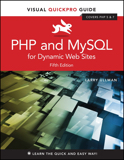- Introduction
- Chapter 1: Introduction to PHP
- Basic Syntax
- Sending Data to the Web Browser
- Writing Comments
- What Are Variables?
- Introducing Strings
- Concatenating Strings
- Introducing Numbers
- Introducing Constants
- Single vs. Double Quotation Marks
- Basic Debugging Steps
- Review and Pursue
- Chapter 2: Programming with PHP
- Creating an HTML Form
- Handling an HTML Form
- Conditionals and Operators
- Validating Form Data
- Introducing Arrays
- For and While Loops
- Review and Pursue
- Chapter 3: Creating Dynamic Web Sites
- Including Multiple Files
- Handling HTML Forms, Revisited
- Making Sticky Forms
- Creating Your Own Functions
- Review and Pursue
- Chapter 4: Introduction to MySQL
- Naming Database Elements
- Choosing Your Column Types
- Choosing Other Column Properties
- Accessing MySQL
- Review and Pursue
- Chapter 5: Introduction to SQL
- Creating Databases and Tables
- Inserting Records
- Selecting Data
- Using Conditionals
- Using LIKE and NOT LIKE
- Sorting Query Results
- Limiting Query Results
- Updating Data
- Deleting Data
- Using Functions
- Review and Pursue
- Chapter 6: Database Design
- Normalization
- Creating Indexes
- Using Different Table Types
- Languages and MySQL
- Time Zones and MySQL
- Foreign Key Constraints
- Review and Pursue
- Chapter 7: Advanced SQL and MySQL
- Performing Joins
- Grouping Selected Results
- Advanced Selections
- Performing FULLTEXT Searches
- Optimizing Queries
- Performing Transactions
- Database Encryption
- Review and Pursue
- Chapter 8: Error Handling and Debugging
- Error Types and Basic Debugging
- Displaying PHP Errors
- Adjusting Error Reporting in PHP
- Creating Custom Error Handlers
- PHP Debugging Techniques
- SQL and MySQL Debugging Techniques
- Review and Pursue
- Chapter 9: Using PHP with MySQL
- Modifying the Template
- Connecting to MySQL
- Executing Simple Queries
- Retrieving Query Results
- Ensuring Secure SQL
- Counting Returned Records
- Updating Records with PHP
- Review and Pursue
- Chapter 10: Common Programming Techniques
- Sending Values to a Script
- Using Hidden Form Inputs
- Editing Existing Records
- Paginating Query Results
- Making Sortable Displays
- Review and Pursue
- Chapter 11: Web Application Development
- Sending Email
- Handling File Uploads
- PHP and JavaScript
- Understanding HTTP Headers
- Date and Time Functions
- Review and Pursue
- Chapter 12: Cookies and Sessions
- Making a Login Page
- Defining the Login Functions
- Using Cookies
- Using Sessions
- Improving Session Security
- Review and Pursue
- Chapter 13: Security Methods
- Preventing Spam
- Validating Data by Type
- Validating Files by Type
- Preventing XSS Attacks
- Using the Filter Extension
- Preventing SQL Injection Attacks
- Review and Pursue
- Chapter 14: Perl-compatible Regular Expressions
- Creating a Test Script
- Defining Simple Patterns
- Using Quantifiers
- Using Character Classes
- Finding All Matches
- Using Modifiers
- Matching and Replacing Patterns
- Review and Pursue
- Chapter 15: Introducing jQuery
- What is jQuery?
- Incorporating jQuery
- Using jQuery
- Selecting Page Elements
- Event Handling
- DOM Manipulation
- Using Ajax
- Review and Pursue
- Chapter 16: An OOP Primer
- Fundamentals and Syntax
- Working with MySQL
- The DateTime Class
- Review and Pursue
- Chapter 17: Example—Message Board
- Making the Database
- Writing the Templates
- Creating the Index Page
- Creating the Forum Page
- Creating the Thread Page
- Posting Messages
- Review and Pursue
- Chapter 18: Example—User Registration
- Creating the Templates
- Writing the Configuration Scripts
- Creating the Home Page
- Registration
- Activating an Account
- Logging In and Logging Out
- Password Management
- Review and Pursue
- Appendix A: Installation
- Installation on Windows
- Installation on Mac OS X
- Managing MySQL Users
- Testing Your Installation
- Configuring PHP
- Configuring Apache





